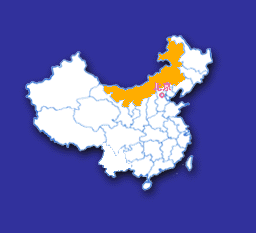
 |
Inner
Mongolia
|

|
|||||||||||
|
|||||||||||
|
|||||||||||
|
Elevation Climate Natural resources Animals
and plants: Hydropower: Forests,
grasslands, and cultivated land: Minerals:
Tourism
Environment
and current policies: The desertification and alkalization of grasslands have brought frequent sandstorms. The deterioration of water conservation capacity of the Greater Hinggan Mountains has resulted in floods in the Songhua and Liaohe river valleys. Each year 300 million tons of soil are washed away in the Yellow and western Liaohe rivers, or 30,000 hectares of land lost. As a result, rivers are choked with silt that stops their flow. To improve ecological environment, the Ecological Construction Project, one of the ten projects of the western development campaign, has been launched recently in the region which includes turning the cultivated land into forests and grasslands, planting grass and suspending animal husbandry, shelterbelts in the northeast, northwest and the north, anti-desertification, virgin forest protection in the Greater Hinggan Mountains, and resettlement. It is expected that by 2005 the deteriorated eco-environment can be brought under control, with first steps at reclamation achieved by 2010, and that mountains will be green and rivers clear again by mid-century.
|
||
|
II.
Population and ethnicity
|
||
|
Population growth rate: 9.7¡ë Life expectancy (average): Ethnicity: Education: In 2000 the region had 10,147 primary schools in 6,299 places, 1,707 middle schools including 1,330 junior secondary schools and 377 senior secondary schools, 425 polytechnic middle schools including 269 junior polytechnic secondary schools and 156 senior polytechnic secondary schools, 18 universities and colleges, and 12 adult-education schools.
|
||
|
III. Economy
|
||
|
GDP: 140 billion yuan (US$16.9 billion) (2000) GDP growth rate: 9.7 percent (2000) and averaging increasing rate of 10 percent during the ninth Five-Year Plan (1996-2000) Average GDP per capita: 5,350 yuan (US$646) (1999) Urban and rural income: From 1989 to 1997 Inner Mongolia was the poorest in China in terms of the disposable per capita income of urbanites and rural residents. In 1999 it ranked 22nd in the country. In 2000 the disposable per capita income of urbanites and rural residents amounted to 5,120 yuan (US$618), 7.3 percent up over the previous year, a 58.9 percent increase over the end of eighth Five-Year Plan period (1991-95), and averaging an annual increase of 9.7 percent. The average per capita income of rural residents hit 2,050 yuan (US$248), with an annual increasing rate of 5 percent. GDP ratio (1st, 2nd, and tertiary industries): 25:39:36 (2000) Added value and growth rate (1st, 2nd, and tertiary industries) (2000): 35.2 billion yuan (US$4.25 billion), 55.2 billion yuan (US$6.67), and 49.6 billion yuan (US$5.99 billion) respectively; 2.6 percent, 12.3 percent, and 11.6 percent increase over the previous year respectively; averaging annual increase rate of 6.4 percent, 11.7 percent, 10.7 percent during the ninth Five-Year Plan (1996-2000). Poverty-alleviation
plan Inflation rate (2000): consumption price 1.3 percent up over the previous year. Unemployment rate: 3.34 percent (2000) Revenues: 15.56 billion yuan (US$1.9 billion) (2000), doubling that by the end of eighth Five-Year Plan period and with an annual increasing rate of 15.3 percent; local revenues being 11 billion yuan (US$1.3 billion) with an annual increasing rate of 20.4 percent. Foreign
trade Foreign
investment Key
industries
|
||
|
IV.
Post and Telecom
|
||
|
|
Telecom
and telephones: Radio
and TV stations
|
|
|
V.
Transportation
|
||
|
Highway Airport |
||
|
VI.
Major fields and projects wanting foreign investment
|
||
|
Projects
available to foreign investment |
||
|
VII.
Favorable policies for foreign investment
|
||
|
¡¡
Article
2 Article
3 Article 4 Inner Mongolia encourages the establishment of foreign invested enterprises involving large investment. 1)
The foreign-funded productive and hi-tech enterprises established in
the development zones, regional capital, and border cities with approval
by the State Council shall be levied the same income tax as foreign-funded
and foreign enterprises in China's coastal opening cities and development
zones. Article
5 Article
6 Article
7 Article
8 Article
9 Article
10 Article
11 Article
12 Article
13 Article
14 Article
15 Article
16 Article
17 Article
18 Article
19 Article
20 1)
No inspection and punishment is allowed to be given to the foreign invested
enterprises without the guideline of laws, rules, and regulation. Article
21 Article
22
|
||